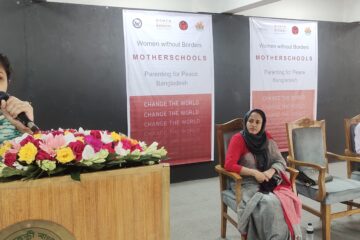BDRunner Online, 21 April: A heatwave is a meteorological phenomenon, that is typically found to occur in Bangladesh during the summer and monsoon seasons. However, no formal and standard definition of heatwave can be applicable everywhere. It varies from country to country and organization to organization.
Changing climatic patterns is accelerating the intensity and severity of the heat wave; it is one of the most dangerous risks. It causes mayhem and harms human health, producing heat exhaustion, dehydration, and heat stroke. Additionally, it is to blame for a sizable number of deaths worldwide, and Bangladesh is no exception.
A heat wave happens when the daily maximum temperature exceeds 36 degrees Celsius across a vast area. It is particularly risky in Bangladesh due to the high moisture content of the air, whereas high moisture levels inhibit the body’s natural cooling system.
Dhaka, the capital of Bangladesh, has recently experienced an excessive heatwave; hence the city has suffered a lot. In 2022, the month of August, this country saw record temperatures in the last three decades. While heat waves have always existed, the difficulty currently is that, as a result of climate change, intense heat is becoming more severe and frequent.
A study published by the Adrienne Arsht-Rockefeller Foundation Resilience Center found Dhaka is losing USD 6 billion worth of labor productivity yearly due to heat stress from extreme temperatures. This amounts to over 8 percent of the city’s annual labor output, and unless measures are taken to reduce global warming, this number could rise to 10 percent by 2050.
Bangladesh loses 7 billion working hours annually due to excessive heat. Assuming a 12-hour workday, a worker loses approximately 10 minutes of working time owing to extreme heat. Bangladesh loses 254 hours of labor per person yearly as a consequence of heat stress.
The temperature varies intermittently in different parts of Dhaka. Some of Dhaka’s most impoverished regions are most affected by heat waves. Temperatures are often higher than in the surrounding area, with a large concentration of informal settlements and widespread usage of corrugated iron sheet roofing.
The lack of greenery and the usage of corrugated iron sheets make the poorest places hotter. These absorb heat throughout the day and cannot sufficiently release heat at night. Due to the high-rise structures that surround these locations and block wind circulation, the air becomes trapped, making the area hotter and uncomfortable.
Extreme heat has the greatest impact on those who are already living in poverty. Poor people face health hazards owing to excessive temperature. Heatwaves frequently have complicated impacts on human economies due to lower worker productivity, particularly among informal workers and different outdoor workers.
Heat has the greatest impact on worker productivity and economic losses, and it has already resulted in losses of up to 10% of income in sectors such as garment production, transportation, and retail commerce, where wages are already below average.
Manufacturing losses are particularly significant in industries like brick and garment manufacturing because workers are subjected to higher temperatures because of their proximity to machinery and ovens. The loss of livestock or crops due to excessive heat puts a hardship on people’s ability to provide for their necessities.
Most workers, such as agricultural and informal workers, work in outdoor conditions and are subjected to high heat. They become dehydrated quickly, and heat stress symptoms such as heat stroke, fatigue, and cramps worsen, limiting their working hours.
Due to the extreme heat and humidity, an individual cannot stay in one spot for more than six hours if the temperature exceeds 35 degrees Celsius. And there is no doubt that such circumstances significantly reduce working hours.
The evidence is apparent that people on Medicare are more likely to be hospitalized and die during a heat wave. Infants, persons with heart failure, kidney disease, chronic lung disease, pregnant women, and the impoverished are all in danger.
According to health experts, the high temperatures will force hundreds of thousands of people in Dhaka, who already have little access to drinking water, to increase their water consumption. The lives of hundreds of thousands of people whose livelihoods rely on outdoor activities may be endangered if the government fails to provide safe drinking water and educate them about the dangers of prolonged exposure to the sun.
Health experts typically advise those who rely on outdoor activities for their livelihood to start their days early and spend less time in the sun. They also encouraged people to seek shade whenever possible and bring umbrellas and drinking water.
Heat-related mortality and dangers can be greatly reduced by implementing some precautions. The WHO has already given public health recommendations on dealing with excessive heat to the general public and medical professionals. India has implemented the HEWS (Heat Early Warning System) program to prevent heat-related mortality and dangers. Bangladesh should pursue comparable measures for the country’s largest cities, particularly Dhaka and Chattagram.
Furthermore, implementing the Heat Adaptation Plan (HAP) at the city and administrative levels, as well as mass awareness and knowledge campaigns, infrastructure, and technological development, can improve overall understanding and promote necessary actions to remedy the effects of heat waves in Bangladesh.
The authorities must ensure that sheds and green spaces in metropolitan areas are equipped with drinking water sources so that people can rest on hotter days. They must subsidize agriculture for farmers to employ workers in two shifts. They must also provide universal health insurance to all citizens so that they may access decent healthcare at any time, which will encourage them to remain employed even under difficult circumstances.
Extreme heat has a disproportionate impact on the impoverished. The situation is unquestionably unsustainable, and if immediate action is not taken, not only will the poor suffer, but our entire urbanized economy will be stressed. The uncontrolled urbanization of Dhaka must be dealt with immediately, and the authorities must show their commitment to making the city livable by taking effective action to minimize heat stress.




